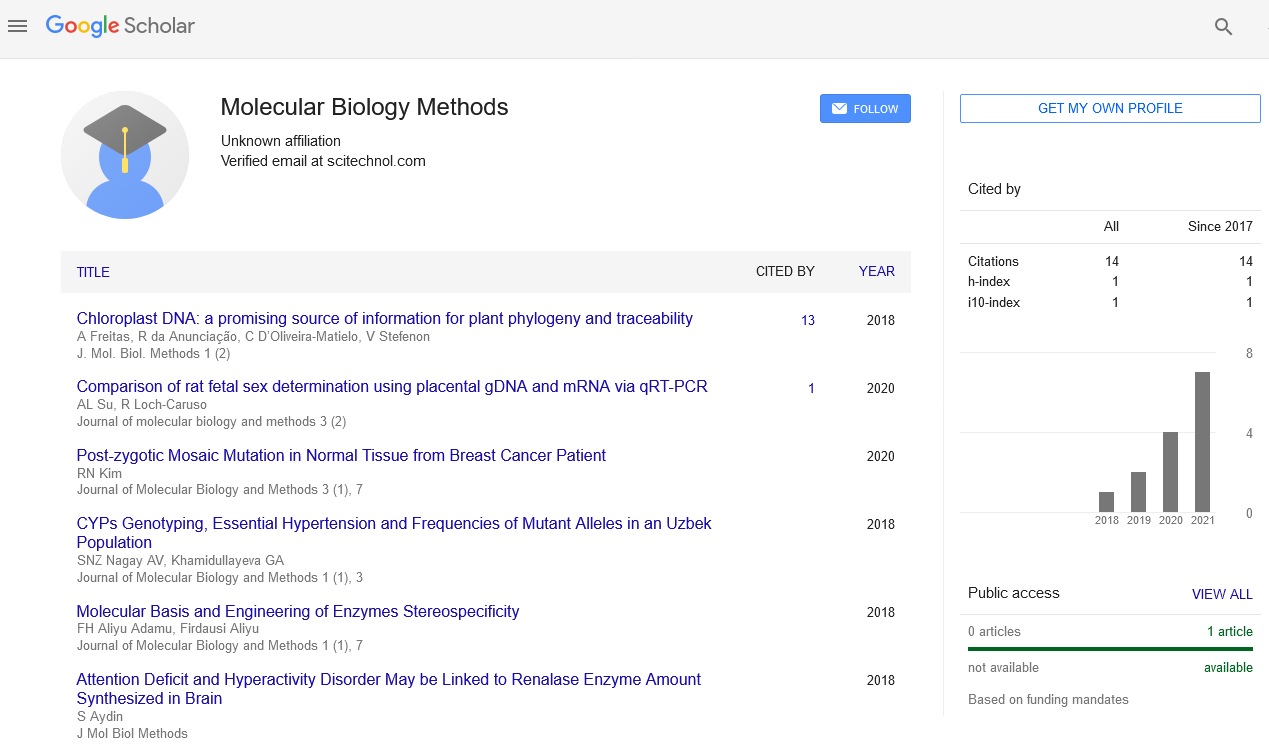Commentary, J Mol Biol Methods Vol: 7 Issue: 1
Unraveling the Intricacies of Epigenetics: An Exploration of the Changing Interaction Between Nurture and Nature
Anup Hankey*
1Department of Biochemistry, MIT World Peace University, Maharashtra, India
*Corresponding Author: Anup Hankey,
Department of Biochemistry, MIT World
Peace University, Maharashtra, India
E-mail: hankeyanup@gmail.com
Received date: 26 February, 2024, Manuscript No. JMBM-24-136918;
Editor assigned date: 29 February, 2024, PreQC No. JMBM-24-136918 (PQ);
Reviewed date: 14 March, 2024, QC No. JMBM-24-136918;
Revised date: 21 March, 2024, Manuscript No. JMBM-24-136918 (R);
Published date: 28 March, 2024 ,DOI: 10.4172/JMBM.1000149
Citation: Hankey A (2024) Unraveling the Intricacies of Epigenetics: An Exploration of the Changing Interaction Between Nurture and Nature. J Mol Biol Methods 7:1.
Description
In the world of genetics, the term "epigenetics" serves as a gateway to understanding the dynamic interplay between nature and nurture. While genetics deals with the DNA sequence as the blueprint of life, epigenetics explores the molecular mechanisms that orchestrate gene expression patterns without altering the underlying DNA sequence. This burgeoning field not only revolutionizes our comprehension of inheritance but also sheds light on how environmental factors sculpt our biological destiny.
At its core, epigenetics encompasses a myriad of molecular processes that regulate gene expression, thereby influencing cellular functions and organismal development. Unlike mutations that alter the genetic code, epigenetic modifications modify gene activity without changing the DNA sequence. These modifications include DNA methylation, histone modifications, and non-coding RNAs, all of which collectively constitute the epigenome.
DNA methylation, the most widely studied epigenetic modification, involves the addition of a methyl group to the cytosine base of DNA, typically occurring at CpG dinucleotides. This modification, catalyzed by DNA methyltransferases, often leads to gene silencing by impeding the binding of transcription factors or recruiting proteins that modify chromatin structure, thus rendering genes inaccessible for transcription.
Histones, the proteins around which DNA is wound to form chromatin, undergo various post-translational modifications, such as acetylation, methylation, phosphorylation, and ubiquitination. These modifications alter chromatin structure, thereby influencing the accessibility of DNA to transcriptional machinery. For instance, histone acetylation generally correlates with gene activation, whereas histone methylation can either activate or repress gene expression, depending on the specific lysine residue targeted and the degree of methylation.
Non-coding RNAs, including microRNAs and long non-coding RNAs, regulate gene expression at the post-transcriptional level. MicroRNAs, short RNA molecules, typically bind to complementary sequences on target mRNAs, leading to their degradation or translational repression. Long non-coding RNAs, on the other hand, exert diverse regulatory functions, including chromatin remodeling, transcriptional interference, and modulation of mRNA stability.
Epigenetic mechanisms play pivotal roles in orchestrating cellular differentiation during development, ensuring the precise activation and silencing of genes essential for cell fate determination. For instance, the process of genomic imprinting, whereby certain genes are expressed exclusively from either the maternal or paternal allele, is regulated by epigenetic marks established during gametogenesis and maintained throughout development. Disruption of these marks can lead to developmental disorders and diseases, underscoring the importance of epigenetic regulation in embryonic development.
Moreover, epigenetic dysregulation has been implicated in a myriad of human diseases, including cancer, neurodevelopmental disorders, and metabolic syndromes. In cancer, aberrant DNA methylation and histone modifications often lead to the silencing of tumor suppressor genes or the activation of oncogenes, driving tumorigenesis and disease progression. Similarly, alterations in epigenetic marks have been implicated in neurodevelopmental disorders like autism spectrum disorders and intellectual disabilities, highlighting the intricate interplay between epigenetics and brain development.
One of the most intriguing aspects of epigenetics is its responsiveness to environmental cues, offering a mechanism through which environmental factors can leave lasting imprints on the genome. Environmental exposures, such as diet, stress, toxins, and social experiences, can induce changes in the epigenome, thereby shaping gene expression patterns and phenotypic outcomes across generations. This phenomenon, known as "epigenetic inheritance," challenges the traditional view of inheritance solely through genetic means and underscores the role of environmental factors in shaping phenotypic variation.
For example, studies have demonstrated that maternal diet during pregnancy can influence the epigenetic regulation of genes involved in metabolic pathways, predisposing offspring to obesity and metabolic disorders later in life. Similarly, exposure to stress during critical periods of development can lead to persistent changes in the epigenome, predisposing individuals to psychiatric disorders and cognitive impairments.
The dynamic nature of epigenetic modifications offers promising avenues for therapeutic interventions in various diseases. Epigenetic drugs, such as DNA methyltransferase inhibitors and histone deacetylase inhibitors, have shown efficacy in reversing aberrant epigenetic marks associated with cancer and other diseases. These drugs work by reactivating tumor suppressor genes or silencing oncogenes, thereby inhibiting tumor growth and restoring normal cellular functions.
 Spanish
Spanish  Chinese
Chinese  Russian
Russian  German
German  French
French  Japanese
Japanese  Portuguese
Portuguese  Hindi
Hindi 